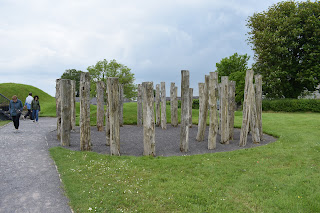Wednesday we decided to spend a day in the woods. We went to Glendalough.
Glendalough is south of Dublin, and its name means "glen of the two lakes." It is one of the most important monastic sites in Ireland. It was founded somewhere around 600 by St Kevin, an ascetic who gave up the noble life he was born to for one of prayer and contemplation. Unfortunately for Kevin, he was so good at what he did that people wanted to come and learn from him, which left him little time for prayer and contemplation. He established a monastery at Glendalough, and then ran away briefly.
The site has a round tower, several churches, some stone crosses, a site called Kevin's Cell, and another called Kevin's Bed. Several stories are told about Kevin. The one I liked best involved a hollowed out stone and a deer. Seems some ladies showed up at Glendalough, seeking shelter, but had nothing to feed their babies. A passing deer stood up on the stone and allowed herself to be milked, so that the milk could be fed to the babies. Apparently, the animals also trusted Kevin.
We were sore from hiking Dublin the day before, but it was still a lovely day in a lovely place. Wanna see some pictures?
This is inside the cathedral. It was dedicated to SS Peter and Paul, probably started in the 10th century, but ceased being a cathedral by 1214.
A stone cross in the cemetery surrounding the cathedral. The cemetery is still in use,
St Kevin's church, also called St Kevin's Kitchen, because the tower looked like a chimney, to some.
Probably from the 12th century.
The Round Tower at Glendalough, built between 900 and 1200, was used for a bell, to call monks to prayer. Its floor is high above the ground, and the tower had several floors. The thinking is that, if someone were to attack, the monks could climb inside, and pull up the ladder, closing themselves in for safety.
The Reefert Church. Built around 1100, its name comes from the Irish, and refers to its use; it was where the local kings, from the O'Toole family, were buried.
Guess what this is?
St Kevin's Cell.
The Upper Lake of Glendalough. Seems I missed out on taking a picture of the Lower Lake, but this one is prettier, anyway.
Heading back to Dublin, we found the Old Military Road, built by the British for use when they were searching for Irish rebels after the Rebellion of 1798. We went up through Glenmacness and over the Sally Gap. It was beautiful, reminding us of Skyfall, or the Trail Ridge Road in Rocky Mountain National Park.
These yellow-flowering shrubs were everywhere, used as hedges for animals. They're called gorse, and they can be as much an aggravation as they are pretty. And they smell, surprisingly, like coconut! (I found out today that the flower is poisonous, but, when the seed forms, it is edible, and is like a pea.)



















































